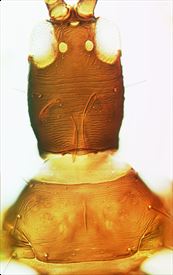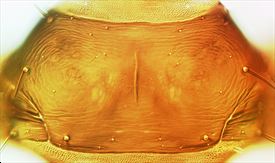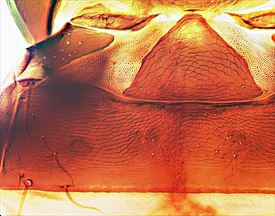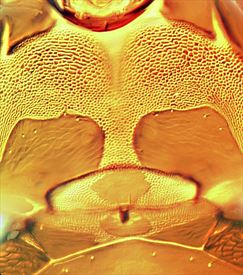Distinguishing features
Both sexes fully winged. Body brown, tube darker; base of antennal segment III and sometimes fore tarsi paler; major setae pale brown; anal setae dark; fore wings pale brown, darker at base, fringe cilia darker. Body size variable; head about as long as tube, slightly constricted at base; cheeks with a few prominent setae, particularly in larger specimens; posterior margin with a pair of postoccipital projections; postocular setae bluntly pointed, arising well behind eyes; maxillary stylets close together, retracted about halfway into head; maxillary bridge faintly visible. Antennae 8-segmented; segments III and IV each with 3 short sense cones. Pronotum transverse, median length short, particularly in small females; major setae bluntly pointed, epimeral setae longest; basantra absent; mesopresternum divided into 2 triangular plates with rounded angles, the median distance between their bases about one-third of mesoeusternum margin; mesoeusternum usually broadly rounded on anterior margin. Metanotum strongly reticulate except medially; fore wings with 25–43 duplicated cilia. Abdomen: pelta triangular; tergites strongly sculptured; tergite II with no posteroangular setae, III–VII with posteroangular setae on pleurotergites; tergite IX posteromarginal setae pointed, nearly as long as tube, S2 longer than S1; tube long, slightly constricted at apex; anal setae as long as tube.
Male similar to female, pronotum more elongate, tube relatively longer; tergite IX posteromarginal setae S2 about as long as S1; sternite VIII with large, transverse pore plate not extending to anterior or posterior margins; large males with fore tarsal tooth and fore femora swollen.
Related species
There are six species in the genus Cartomothrips, of which three are known only from Australia, one known only from New Zealand, and two that are known from both countries. C. manukae has the tergal setae longer than in the other species, and setae S2 on tergite IX of males is as long as the other major setae on this tergite.
Biological data
Presumably feeding on fungal hyphae or their break-down products, the adults and larvae of C. manukae live on the dead branches, twigs, and fruit capsules of Leptospermum ericoides, L. scoparium, and Metrosideros perforata.
Distribution data
Widespread and common in New Zealand (Three Kings Is / ND, AK, CL, BP, TO, TK, WN / SD, NN, BR, KA, MC, SC, MK, CO, DN, SL / SI), this species has also been found in large numbers in Tasmania, and there is one record from South Australia.
Family name
PHLAEOTHRIPIDAE, PHLAEOTHRIPINAE
Species name
Cartomothrips manukae Stannard
Original name and synonyms
Cartomothrips manukae Stannard, 1962: 40
References
Mound LA & Walker AK (2012) The Australia-New Zealand connection re-visited, with two new species of Cartomothrips (Thysanoptera, Phalaeothripidae). Zootaxa 3487: 58–64.




